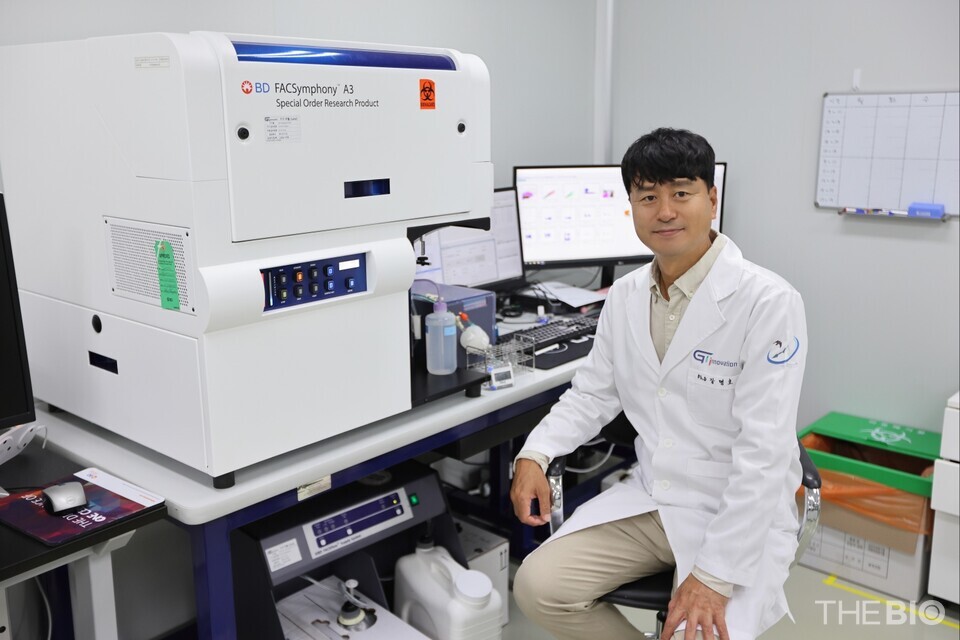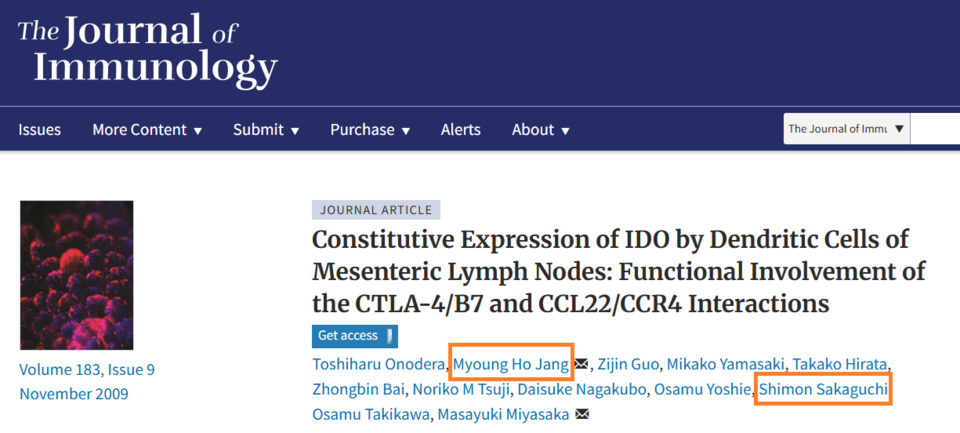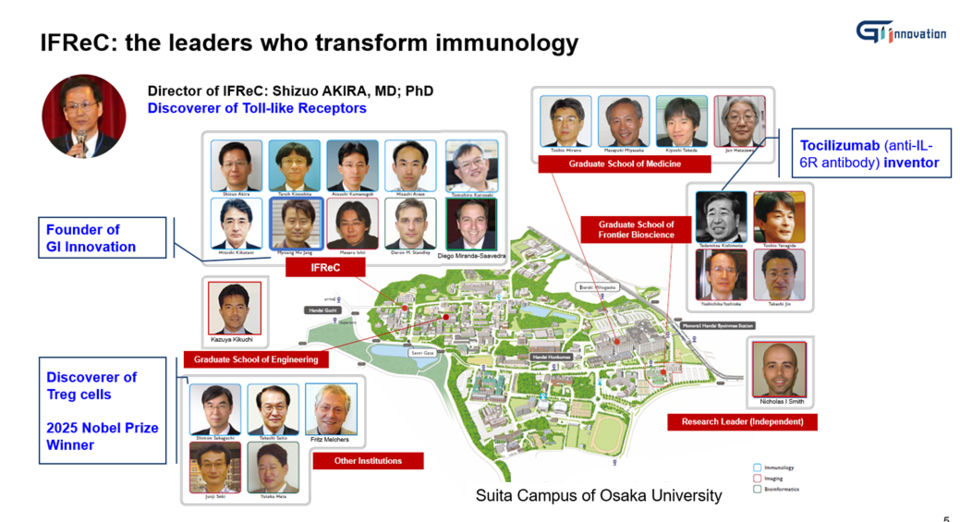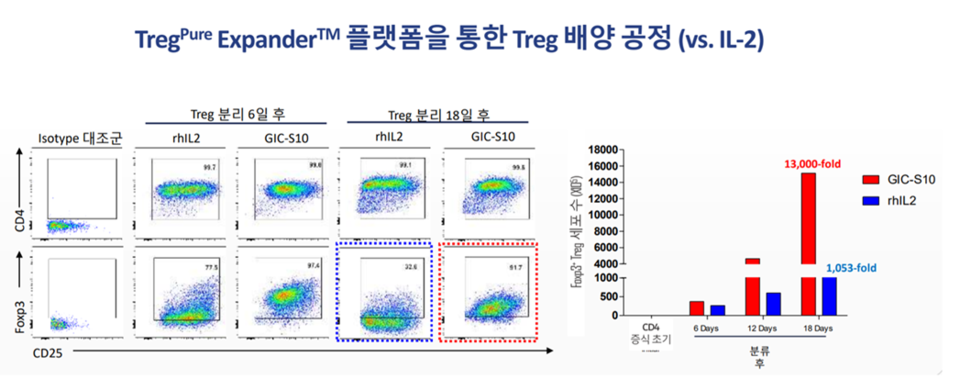- [Interview] "Transforming the paradigm with regulatory T cells (Tregs)...Continuing the legacy of Nobel Prize-winning 바카라사이트 벳페어"
- 바카라사이트 벳페어 Innovation's '바카라사이트 벳페어-101·102': Next-generation immunocytokines designed to suppress Tregs
- 바카라사이트 벳페어 CELL's 'Drone-Treg': Treating autoimmune diseases by mass-producing Tregs

[by Lee, Young Sung] This year's Nobel Prize in Physiology or Medicine was awarded to Professor Shimon Sakaguchi of Osaka University, in recognition of his groundbreaking discovery of regulatory T cells (Tregs), a finding that revolutionized the global paradigm of immune tolerance. Jang Myoung-ho, CEO of 바카라사이트 벳페어-Innovation and a former professor at the University of Osaka, who previously conducted research alongside Professor Sakaguchi, expressed deep emotion and admiration upon learning of the award. Over a decade ago, Jang co-authored a research paper with Sakaguchi [screenshot of the paper below] reflecting their shared contribution to the field of immunology.
In an interview with <THE BIO> on October 13, Jang stated, "The insights I gained through my research with Sakaguchi served as the foundation for the establishment of GI-Innovation," adding, "This award is all the more meaningful for me personally."

From 1999 to 2013, 바카라사이트 벳페어 conducted research at Osaka University Graduate School of Medicine and the Immunology Frontier Research Center (IFReC) of Osaka University. After receiving his doctoral degree in 2004, he continued his academic career as a postdoctoral fellow and later as an assistant professor, before joining IFReC in 2007 as an Associate Professor and Principal Investigator (PI).
The Immunology Frontier Research Center (IFReC) is a world-class research institute established by Osaka University as a global hub for immunolo바카라사이트 벳페어cal research. It brings together internationally renowned immunolo바카라사이트 벳페어sts, including Nobel Prize-nominated scientists, who lead pioneering studies in the core domains of modern immunology, notably Toll-like receptors (TLRs), cytokines, Tregs, and intestinal immunity.
In addition, the 바카라사이트 벳페어 activities of Professor Kishimoto Tadamitsu of Osaka University, who, together with Chugai Pharmaceutical, developed the world-renowned rheumatoid arthritis treatment Actemra (tocilizumab), have continued to receive substantial support through royalties and foundation funding. In 2016, Chugai Pharmaceutical of Japan announced a JPY 10 billion (approximately USD 10 million) endowment to IFReC, to be distributed over a 10-year period. IFReC is widely regarded as a model example for successful collaboration among industry, academia, and 바카라사이트 벳페어 institutions.
The connection between Jang and Sakaguchi originated from IFReC itself, where their research labs were located in close proximity, Sakaguchi’s laboratory on the 9th floor and Jang's laboratory directly below on the 8th floor.

The core discovery for which Sakaguchi received the Nobel Prize in Physiology or Medicine was the identification of regulatory T cells (Tregs). Sakaguchi and 바카라사이트 벳페어's joint research extended beyond this achievement.
In 2009, through joint research, Sakaguchi and Jang discovered that CTLA-4 (Cytotoxic T-Lymphocyte Antigen-4), expressed by regulatory T cells, binds to CD80 on dendritic cells, thereby inducing the secretion of the immunosuppressive molecule IDO. This mechanism mediates ‘regulatory T cell-induced immunosuppression’ and constitutes the core finding of their co-authored research paper.
"GI Innovation, which I founded after graduating from Osaka University, along with its subsidiary GI CELL, is developing anticancer and autoimmune disease treatments based on these research findings," Jang explained.
GI Innovation's anticancer drug candidates, ‘GI-101’ and ‘GI-102,’ are designed as fusion molecules combining CD80 and interleukin-2 (IL-2). In this mechanism, CD80 binds to CTLA-4 expressed on Tregs, thereby inhibiting the binding of CD80 on dendritic cells to CTLA-4. This process effectively blocks the immunosuppressive function of Tregs, leading to the activation of T cells and NK cells that directly attack cancer cells.
"Especially in cancers such as triple-negative breast cancer (TNBC), head and neck cancer, and melanoma, elevated levels of Tregs are associated with poorer prognoses, making Treg suppression a crucial factor in achieving anticancer efficacy," Jang emphasized. "We developed GI-101 and GI-102 specifically to suppress Tregs."
"In contrast, for autoimmune diseases, it is necessary to increase Treg levels to suppress excessive immune responses. To this end, GI CELL has developed 'Drone-Treg,' a therapeutic candidate aimed at treating intestinal inflammatory diseases," Jang further commented.

Drone-Treg is a cell therapy that involves the mass production of autologous Tregs derived from a patient's own blood using 바카라사이트 벳페어 CELL's proprietary platform technology, followed by their reintroduction into the patient. By equipping these Tregs with chemokine receptors and integrins that promote intestinal migration, the therapy can be delivered to the intestinal tissue.
"We have confirmed that Drone-Tregs, developed through this process, effectively restored damaged intestinal epithelial cells in a mouse model of inflammatory bowel disease," Jang explained.
"I had long expected Professor Sakaguchi would eventually receive the Nobel Prize. When he first discovered Tregs, there was considerable skepticism, but I am truly delighted that his persistent research has finally borne fruit and been recognized with this honor," Jang remarked.
"GI Innovation aims to carry forward this legacy by advancing our clinical development as swiftly as possible, and we are committed to contributing to human health through the development of innovative novel drugs based on Treg regulation," Jang further stated.
